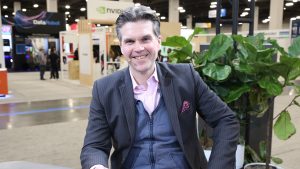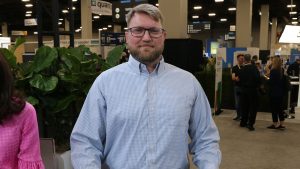Networking Evolves for Virtualization, Cloud Computing Demands
![]() As more data centers go virtual and cloud computing – both public and private clouds – gains adoption, HP believes the network needs to become flatter in order to keep up.
As more data centers go virtual and cloud computing – both public and private clouds – gains adoption, HP believes the network needs to become flatter in order to keep up.
Specifically, the industry needs to remove unnecessary layers from the network to reduce latency and increase performance of federated applications and virtual machine mobility, said Mike Banic.
Banic, Vice President of Marketing for HP’s networking division, joined Wikibon’s Dave Vellante and SiliconANGLE.com’s John Furrier live inside theCube from the floor of VMworld 2011 to discuss the role of networking in virtualized environments. The discussion was part of the Virtual Networking Spotlight sponsored by HP.
Banic pointed out that more than half of VMware deployments run on HP servers. HP as such is focusing much of its attention on optimizing on vMotion.
“vMotion is becoming the new killer app in the data center,” Banic said. “What we’ve found is that vMotion can actually run twice as fast and in the event of a network failure our innovations actually recover 500x faster (with HP technology) than traditional networking protocols like spanning tree.”
To flatten the network, HP is relying on its Flex Fabric offering. Banic compared current networking routes to a recent direct flight he took from San Francisco to Japan. The trip didn’t require him to stop in Los Angles, then Hawaii, then Bangkok first.
If it did, “It would be very slow and long and it would be a horrible user experience,” Banic said. “Well, that’s what’s happening in today’s data centers. Legacy hierarchical, multi-tiered data centers are forcing traffic between servers to take that kind of path. What we really want for better performance and a better user experience is that direct flight.”
Later in the spotlight, Broadcom’s Sujal Das joined Wikibon Analyst Stu Miniman to discuss the latest trends in network management in virtualized environments. He said increasingly vendors like VMware and organizations like Open Stack are pushing the notion of separating virtual network from the physical network.
![]() As a result, “We [Broadcom] have to support both modes and we have enabled our switches to support both,” said Das, who is a product line director at the company.
As a result, “We [Broadcom] have to support both modes and we have enabled our switches to support both,” said Das, who is a product line director at the company.
Streamlining network management functions is also key, according to Jason Nash, a data center solutions principal at Varrow, who joined Miniman and Das on the panel.
“It’s important to give network administrators a single point to administer both physical and virtual networks,” Nash said.
Cloud computing is also having a big impact on the development of networking technology
“The cloud is driving the network to become a lot more malleable and fungible on the fly because if you’re going to provision resources and move resources around you’re going to need to be able to have a network that’s changeable on the fly as well,” said Nick van der Zweep, director of business strategy at HP’s Industry-Standard Servers and Software division.
![]() HP’s cloud system, van der Zweep told Wikibon’s Vellante, is a turnkey cloud environment that can deploy either or physical or virtual machines. The network fabric is “enhanced through something called virtual fabric.”
HP’s cloud system, van der Zweep told Wikibon’s Vellante, is a turnkey cloud environment that can deploy either or physical or virtual machines. The network fabric is “enhanced through something called virtual fabric.”
“The network is much more fungible and changeable through software control as opposed to static NIC, static design,” he said.
Explained van der Zweep:
“We’ve simplified it tremendously for customers … you can take any server with a minimum of 20Gb of capacity bandwidth on it and you can connect to any network. You can connect it to iSCSI, to fiber channel, to Ethernet connections, and slice-and-dice that up at will on the fly. So instead of having to pre-think things months ahead and order it and put it in place, you just get an HP blade system with virtual connect. If you want bandwidth for your database, you got it. If you want to reconfigure it to be an ESX server, we’ve done it.”
The result, observed Vellante, is that “you’re able to accommodate 10-times the traffic, the complexity, the data of that old world.”
Absolutely, agreed van der Zweep . “We can juice up a single blade to 192Gb per second of bandwidth…that’s a lot of bandwidth that you can slice-and-dice anyway you want.”
A message from John Furrier, co-founder of SiliconANGLE:
Your vote of support is important to us and it helps us keep the content FREE.
One click below supports our mission to provide free, deep, and relevant content.
Join our community on YouTube
Join the community that includes more than 15,000 #CubeAlumni experts, including Amazon.com CEO Andy Jassy, Dell Technologies founder and CEO Michael Dell, Intel CEO Pat Gelsinger, and many more luminaries and experts.
THANK YOU













